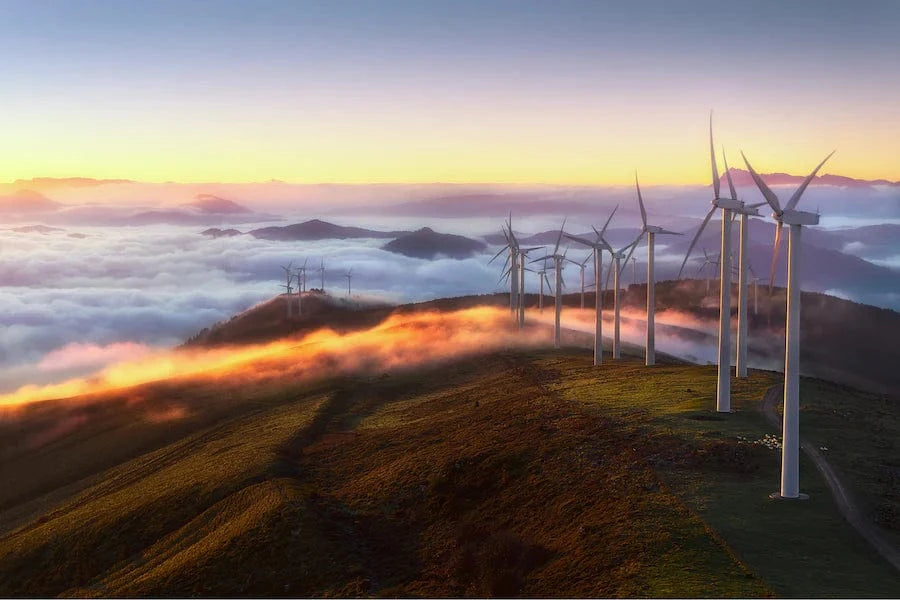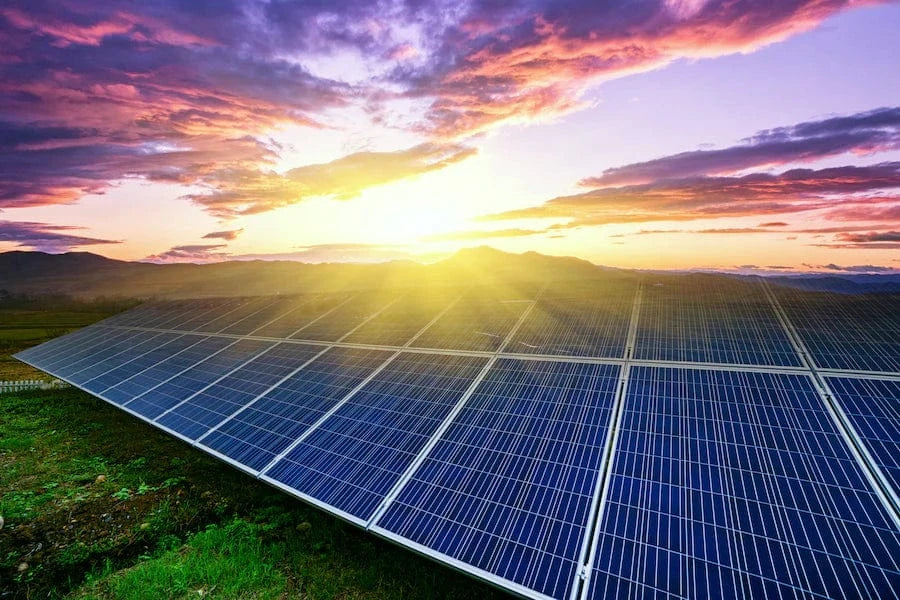
Get news, updates, & event Info delivered right to your inbox:
Renewable Energy Can Power The World — Here's How
When it comes to restoring degraded landscapes and absorbing carbon, we're strong believers in the power of planting trees. But reforestation is just one of several things we must do to protect the planet. Another essential action is to green up our power supply so that we aren't emitting as many greenhouse gases in the first place. In other words, we need to switch to renewable energy.
At its most basic level, renewable energy is "energy from a source that is not depleted when used." Seems like a no brainer, right? And if you're like us: concerned about climate change and looking for ways to reduce your impact, you've likely realized that one of the best ways to lower your carbon emissions is by adopting proven renewable energy technologies.
Some have been around for centuries, while others are more novel, but when you think about renewable resources, your mind probably goes straight to solar energy and wind energy, which are the two fastest growing renewable energy sources in the world. While they both are very promising renewable energy examples, there's more out there — like hydropower, wave power, geothermal energy, and hydrogen.
But from controversial hydroelectric dams to noise pollution from wind turbines, some are more controversial than others. Still, all are worth watching as the technologies continue to be refined to increase their efficiency and reliability — and reduce environmental impacts.
6 Types of Renewable Energy You Should Know

1. Wind Power
The second most widely-used source of renewable energy (24% of the world’s renewable energy generation capacity), wind power is harnessed by turning a wind turbine’s propeller-like blades around a rotor, which powers a generator and creates electricity. Wind turbines have been used on farms and homesteads for centuries, mostly for things like grinding grain and pumping water.
Lead by China, the United States, Germany, Spain, India, the UK, Italy, France, Brazil, Canada, and Portugal, the world is increasingly adopting wind power to meet its energy needs. And while it certainly deserves its place of prominence, wind turbines have some hidden costs, like high bird fatalities and noise pollution to nearby communities. Some people also consider them to be an eyesore. Still, they’re a step in the right direction and are significantly less problematic than conventional power plants.

2. Solar Energy
With more than 486GW of installed capacity, solar energy is the fastest-growing renewable power source. The most popular technologies are photovoltaic (PV) and concentrating solar power (CSP). Solar panels (PV) work when their photovoltaic cells generate electricity by absorbing sunlight and using its energy to create an electric current.
Concentrating solar power (CSP) plants also harness the power of the sun, but in a very different way: they use specialized mirrors to concentrate its energy and drive traditional steam turbines or engines to create energy. The thermal energy concentrated in CSP plants can then be stored and used to provide electricity whenever it’s needed.
China, the United States, Germany, Japan, Italy, and India lead in PV capacity, while Spain has 42% of global CSP capacity. Solar power is awesome, but it isn’t perfect — photovoltaic cells and the batteries needed to store their energy are made with toxic chemicals and materials. CSV uses hazardous fluids to transfer heat, and if allowed to leak, they can damage the surrounding environment. Solar panels also take up a lot of space, and solar farms are not aesthetically pleasing to most people. Despite these issues, solar is a great technology with a lot of potential!

3. Ocean thermal Energy
Two types of energy can be harnessed from the ocean: thermal energy from the sun’s heat and mechanical energy from the motion of tides and waves. Ocean thermal energy uses the ocean's warm surface water to vaporize fluids with a low boiling point (like ammonia). The vapor created spins a turbine attached to a generator to produce electricity.
Ocean mechanical energy harnesses the ebbs and flows of tides, which are caused by the rotation of the earth and the gravitational influence of the moon. Ocean waves are converted to electricity when they move wave energy converter (WEC) devices, which are attached to generators that can covert this energy into electricity. Several other ocean-based technologies have also shown promise and are in development.
The United States, the UK, Russia, Australia, Sweden, Ireland, Scotland, and the Netherlands lead the world in utilization. However, they can cause coastal erosion, damage the ocean floor, harm marine mammals, create noise pollution, and alter the natural flow of sediment. Still, they are fascinating technologies that deserve more attention as they continue to get refined!

4. Hydrogen Power
As the simplest and most abundant element in the universe, hydrogen is found in organic compounds and water. It's high in energy but produces comparatively little pollution when burned, and has been used to launch space shuttles since the 1950s. So how does hydrogen energy work?
In some cases, hydrogen fuel cells are used to convert the potential chemical energies of hydrogen and electricity into usable power. In other applications, the cells power the combination of hydrogen and oxygen atoms, generating electricity. Pretty cool, right?
However, hydrogen power by nature is unstable and widespread utilization will remain limited until production costs decrease and durability improves. It's also difficult to store due to the small size of the molecules — and pollutes the air with nitrous oxide when burned. For this reason, many see it as a stopgap measure to help reduce GHG emissions from heavy industries while we work to green up our power supply.

5. Geothermal Energy
Geothermal energy comes from the earth’s core, and is tapped by drilling wells 1-2 miles deep into the earth to pump steam or hot water to the surface. Once there, the pressure is dropped, causing the water to become steam that then spins a turbine, powers a generator, and produces electricity.
The United States, the Philippines, Indonesia, Mexico, Turkey, and Italy are the top geothermal power producers in the world. But as you may have guessed, drilling holes deep into the earth’s surface is environmentally problematic — with effects like land degradation, possible depletion of local geothermal resources, and the release of greenhouse gases like hydrogen sulfide, carbon dioxide, methane, and ammonia.
Proponents argue that the GHGs released are significantly lower than that of fossil fuels, but it does beg the question — is it really a renewable energy source?

6. Hydropower
As the most widely-used renewable energy source (18% of the world’s total installed power generation + 54% of the global renewable power generation capacity), we would be remiss not to mention hydropower. The most common method used to harness the power of freshwater is damming up rivers to create massive reservoirs. Then the reservoir water is released, which drives power-generating turbines. China, Brazil, the United States, Canada, and Russia have the biggest hydroelectricity installations in the world.
Of course, this form of hydropower comes at a cost – massive hydroelectric dams damage the environment, disturb aquatic wildlife, and displace nearby populations. Still, humans have been harnessing water for centuries + there are many promising new technologies out there, so we’re hopeful that someday, hydropower will be less damaging to the environment!
There you have it! None of the above mentioned renewable energy technologies are perfect, but many represent a step in the right direction as we navigate the transition to a less environmentally damaging way of life. We're hopeful that as scientists and researchers continue to refine and develop solutions, renewable energy will become more widely adopted. Looking for a simple way to do your part right now? Plant trees with us today!
Get news, updates, & event Info delivered right to your inbox:
Related Posts
9 Sustainable New Years Resolutions
18/12/2025 by Meaghan Weeden
Inspirational Quotes About Trees
16/12/2025 by Meaghan Weeden
The 9 Oldest, Tallest, and Biggest Trees in the World
11/12/2025 by One Tree Planted
Popular On One Tree Planted
Inspirational Quotes About Trees
16/12/2025 by Meaghan Weeden
The 9 Oldest, Tallest, and Biggest Trees in the World
11/12/2025 by One Tree Planted
What Causes Deforestation?
10/07/2025 by Meaghan Weeden
Fundraising Disclosures

Be Part of the
Restoration Movement
The Grove is more than just a monthly giving program: it's a vibrant community of individuals who are dedicated to reforestation and environmental restoration on a global scale.
As a member of The Grove, you affirm your commitment to restoring forests, nurturing biodiversity, and fostering positive global change.



